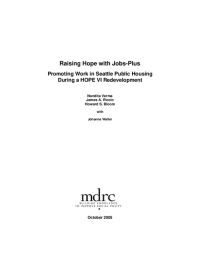Raising Hope with Jobs-Plus
Promoting Work in Seattle Public Housing During a HOPE VI Redevelopment
This report is the final in a series on MDRC’s evaluation of the Seattle site of the Jobs-Plus Community Revitalization Initiative for Public Housing Families (Jobs-Plus), a national demonstration project testing a new employment program for public housing residents. Based in the city’s Rainier Vista housing development, Seattle Jobs-Plus was distinctive because it came to operate the community and supportive services component of the housing authority’s HOPE VI initiative to tear down and rebuild the development as a mixed-income neighborhood. Rainier Vista was also the most ethnically diverse of the six housing developments operating Jobs-Plus. Its tenant population, which included many East African and Southeast Asian immigrants, spoke no fewer than 22 languages.
Jobs-Plus combines on-site employment-related services, new rent rules to allow residents to keep more of their earnings, and a neighbor-to-neighbor outreach strategy to share information about employment opportunities. The program is targeted toward all of a housing development’s working-age, non-disabled residents.
Although selected as a Jobs-Plus site in 1997, Seattle’s receipt of a HOPE VI grant two years later introduced a unique and potentially confounding feature to that site’s program. Because Seattle Jobs-Plus continued to operate in a modified form, MDRC continued evaluating it but with a scaled-back research design. This report describes the program’s effects on residents’ employment and earnings.
Key Findings
- Before the HOPE VI relocation and demolition process was fully underway, Seattle implemented a strong Jobs-Plus program with good results. In the first year of full program operations, residents’ earnings were about 7 percent higher than they would have been in the absence of Jobs-Plus. This effect grew to nearly 11 percent (a gain of $1,050) in the following year.
- Under HOPE VI, the responsibilities of Seattle Jobs-Plus expanded to include assisting all residents (including elderly and disabled residents who were not in the Jobs-Plus target group) with social service and relocation needs, which competed with the core employment focus of Jobs-Plus.
- Seattle Jobs-Plus’s positive earnings effects disappeared around the time the site’s HOPE VI resident relocation process was fully underway. In contrast, the other Jobs-Plus sites with strong programs had sustained and growing earnings effects.
- In Seattle, as in all the sites, the estimated effects of Jobs-Plus on employment rates are less striking than those for earnings. Although Jobs-Plus increased employment rates for some residents, for many others it achieved its earnings effects by improving employment retention, hours worked, or job quality.
The Seattle findings show that a program like Jobs-Plus can be effective in a very diverse public housing community. However, they also caution that the disruptions associated with a large-scale HOPE VI resident relocation process can undermine the program’s effectiveness. Perhaps Seattle Jobs-Plus could have sustained its promising early effects on earnings if it had continued — at least for a time — its intense employment-focused assistance and rent-based work incentives for residents who moved out of the development during the period of mass relocation.







